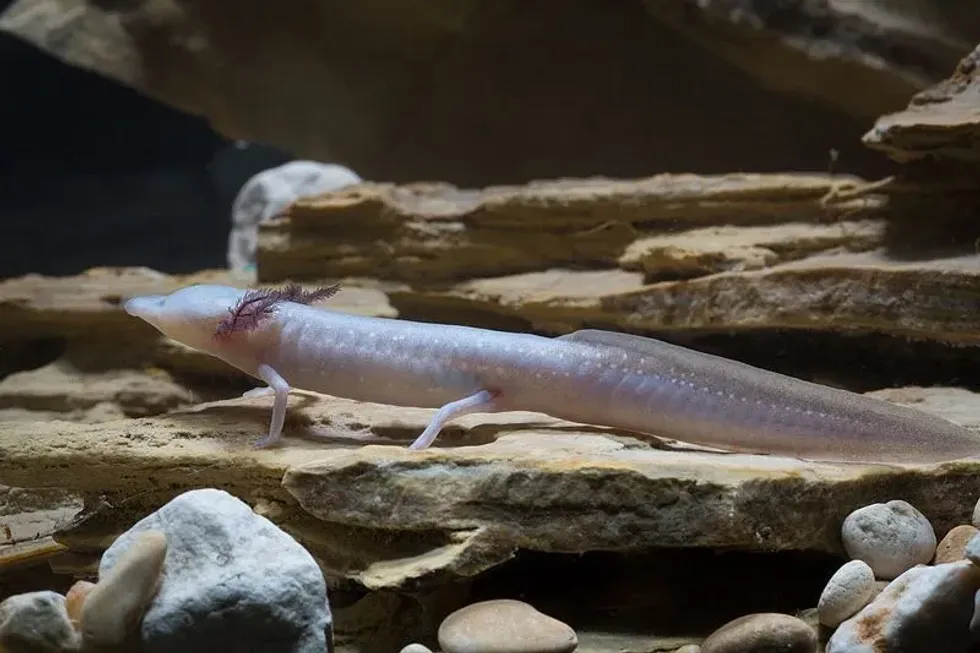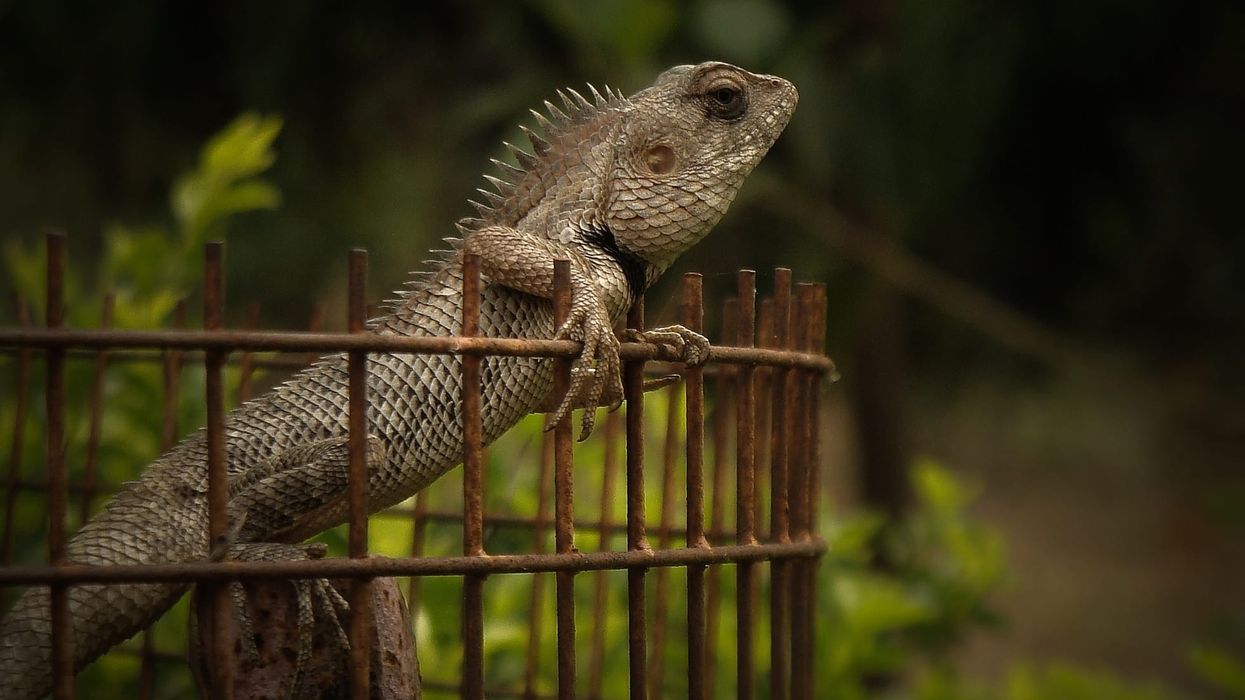Have you ever thought about the several animals that we might never know? The Texas blind salamander is one such species that dwells in the Edwards Plateau region of Hays county.
It is one of the only salamanders that spends its life submerged in water without going to the surface. These salamanders prefer living in freshwater underground caves, and people seldom get to see them. These salamanders are especially found in the Edwards aquifer area inundated by the San Marcos Springs and Comal Springs.
With a flattened head and a sleek body, these salamanders can manage to live for up to 10 years. However, most of its life remains a mystery to us.
Most of the information gathered about the Eurycea rathbuni comes from laboratory studies done on salamanders kept in captivity. One striking thing about these salamanders is its pale skin and bright red gills that help derive oxygen from the water. Unfortunately, due to urbanization and contamination of water, the species has become endangered and is currently listed as Vulnerable.
Want to know more about this rare and endangered species? Keep reading to learn Texas blind salamander facts. Also, check out these articles on marbled salamander facts and arboreal salamander facts to get into the world of other animals.
Texas Blind Salamander Interesting Facts
What type of animal is a Texas blind salamander?
The Texas blind salamander (Eurycea rathbuni) is a rare amphibian found only in some areas of Texas.
What class of animal does a Texas blind salamander belong to?
The Texas blind salamander belongs to the class Amphibia and to the genus Eurycea.
How many Texas blind salamanders are there in the world?
Even though it is known that this species has a dwindling population, making it endangered, the exact population is yet to be known as it has a habit of remaining hidden in the water of the caves.
Where does a Texas blind salamander live?
The Texas blind salamander (Eurycea rathbuni) has been spotted in the San Marcos Fault area of Texas, along with some salamanders belonging to the Purgatory Creek system. Broadly, the area of Texas blind salamanders is noted to be the Edwards Plateau region of Hays County, Texas.
What is a Texas blind salamander's habitat?
As cave salamanders, this species is habituated to living completely submerged in water. It prefers a water temperature of 69.8-71.6°F (21-22°C). Sometimes, these salamanders have also been found in wells. The water source of its habitat is often drawn from the clean and fresh water of the Edwards aquifer.
Who do Texas blind salamanders live with?
Like other salamander species, the Texas blind salamanders are also solitary in nature except for the spawning season. It spends most of its life looking for food in its inhabited area.
How long does a Texas blind salamander live?
Even though a whole lot is not known about the lifespan range of this creature, the average lifespan in captivity is said to be 10.3 years.
How do they reproduce?
We still have to know a lot about the reproduction of this cave-dwelling species. However, it is known that these salamanders have the ability to breed throughout the year.
Most of what we come to know about its spawning and spermatophore deposition comes from laboratory studies where the creatures have been kept in captivity. Studies show that about 8-35 eggs are laid by the females while spawning, and the Texas blind salamander egg is unpigmented.
One unique mating ritual of this species is the spermatophore deposition done by the males during breeding.
The females collect the spermatophore with its cloaca, and this leads to fertilization. It takes 12-16 days for the eggs to hatch.
What is their conservation status?
According to the International Union for Conservation of Nature Red List, the current status of the Texas blind salamander is Vulnerable rather than being endangered.
Texas Blind Salamander Fun Facts
What do Texas blind salamanders look like?

One of the predominant Texas blind salamander characteristics is its blindness. It does have eyes, but the eyes are underdeveloped, making them of no use.
Only slight black dots are seen under its skin on its head which suggests the presence of eyes. These creatures have a long flat head along with a protruding snout. Four legs come out of the body but are thin and rather elongated.
Its tail tapers at the end of the body and the tail is laterally compressed. As this salamander species is neotenic, the larval form is retained throughout its life, and it has bright red gills. The external gills help them to draw oxygen from the water.
There are four digits in its forelimbs and five digits in the hind limbs. The body of these salamanders are almost colorless as it predominantly lives in total darkness present in the cave water systems.
How cute are they?
The Texas blind salamanders have the rudimentary look of its larvae which does make it look cute, in a way.
How do they communicate?
Not much is known about the ways in which these salamanders communicate with its habitat and fellow members of the species. They possibly use the sense of smell and vibrations to perceive their surroundings.
How big is a Texas blind salamander?
The average body length of the Texas blind salamander is around 3.2-5.3 in (8.1-13.4 cm). It is smaller than the Axolotl that has an average body length of 9 in (23 cm).
How fast can a Texas blind salamander move?
We are yet to know about the speed of this species. However, because of its underdeveloped limbs and blindness, we can assume that this isn't a fast moving species.
How much does a Texas blind salamander weigh?
No information is available regarding the average weight of this water dwelling salamander species.
What are their male and female names of the species?
There are no distinct names for the male and female of this species. Sexual dimorphism is also absent in the sexes.
What would you call a baby Texas blind salamander?
A baby Texas blind salamander is called a larva.
What do they eat?
Even though a lot is not known about the diet of these salamanders, a large portion of its food intake consists of shrimp and other aquatic invertebrates.
Are they poisonous?
No, this water dwelling salamander species is not poisonous.
Would they make a good pet?
You couldn't possibly keep a Texas blind salamander as it is a vulnerable species and keeping this rare water dwelling species is absolutely illegal.
Did you know...
As stated, these salamanders do not get up to the surface; hence it can only be seen outside of caves if there has been turbulence in its water habitat.
Why is the Texas blind salamander endangered?
One of the main reasons for the Texas blind salamander getting endangered is its habitat loss. Due to urbanization and groundwater use, the clean and fresh water sources keep on getting polluted.
This leads to a toxic environment where the salamanders are unable to survive, and its food sources also depleted. As a measure for conservation, this species has been listed in the U.S. Endangered Species Act and conservation measures are being put in place.
How can the Texas blind salamander find prey?
One of the best Texas blind salamander adaptations has to be its hunting capabilities even though it is blind. It hunts the shrimp and other prey by sensing their movements through changes in pressure and through vibrations.
Rather than moving upward in the water, this salamander prefers to dwell in the lower levels to get access to the most prey.
Here at Kidadl, we have carefully created lots of interesting family-friendly animal facts for everyone to discover! Learn more about some other amphibians including these red-cheeked salamander facts, and fire salamander facts.
You can even occupy yourself at home by drawing one on our Texas blind salamander coloring pages.










